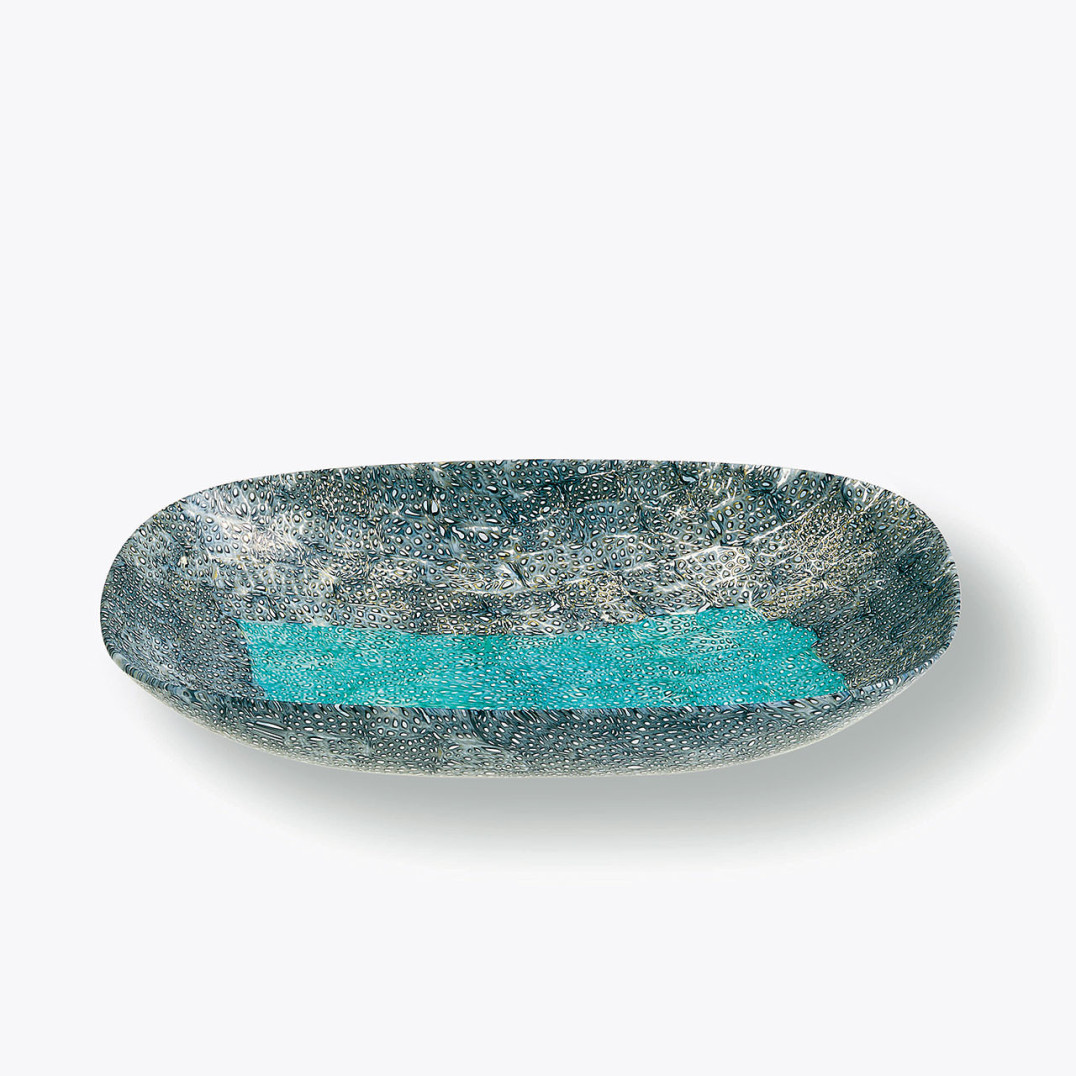
Paolo VeniniA murrine, 1959
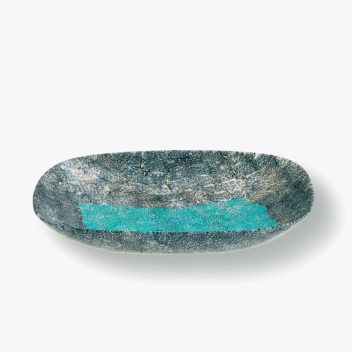
Paolo VeniniA murrineVenini & C., 1959
Bowl crafted with grey and lattimo murrine. The center of the bowl
is composed of turquoise and lattimo murrine.
Paper label: Venini 4880.
1 1/2 in. high x 8 11/16 in. x 5 5/16 in. (3.8 x 22 x 13.5 cm)
Exhibitions:
2000, New York, Venetian Glass, Museum of Arts & Design;
2001, Milan, Murano: Vetri dalla Collezione Olnick Spanu, Spazio Oberdan.
Bibliography and comparative texts:
Venini, grey catalogue, n. 4880;
G. Ponti, 1959;
F. Deboni, 1989, n. 153;
M. Karasik, 1989, n. 33;
A. Venini Diaz de Santillana, 1996, n. 180;
H. Ricke, E. Schmitt, 1996, n. 148;
Olnick Spanu, 2000, n. 97;
Olnick Spanu, 2001, n. 134.
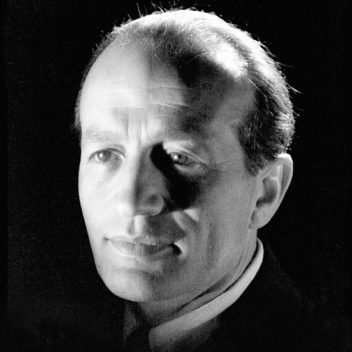
Paolo Venini 1895–1959
Born in Milan, the entrepreneur and designer Paolo Venini was a law school graduate. From 1921 until he died, he dedicated himself to the workshop he founded, the Vetri Soffiati Muranesi Venini & C. (through 1925, Vetri Soffiati Muranesi Cappellin Venini & C.). A man of marked entrepreneurial talent, his goal from the very beginning was to expand his company's influence abroad and he sought the collaboration of the most talented artists and architects of his time, employing them as artistic directors of his company. He always worked at the side of his designers with the goal of anticipating and directing taste. He personally checked every collection produced by his furnace. And his confident aesthetic choices, along with the fine quality of the products, assured his workshop both critical and commercial success. He dedicated himself personally to design from the '30s: his Diamante glass pieces date from 1936, and he created the murrine romane in collaboration with Carlo Scarpa. Following the war, he created bottles with brightly colored stripes, vessels in mosaico zanfirico and mosaico tessuto, glass mosaic windows, and engraved vessels. In collaboration with Bianconi, he created vessels such as the fazzoletti, which are a classic example of the production of the '50s, and were enormously successful.
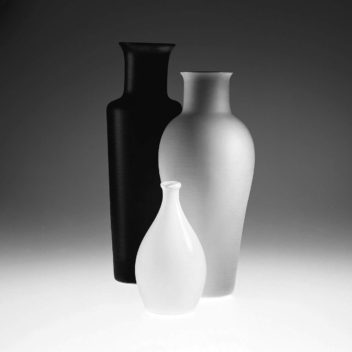
Venini & C. 1932–2001
In 1932, when both Martinuzzi and Zecchin left the company, Paolo Venini changed the name from Vetri Soffiati Muranesi Venini & Co. (V.S.M. Venini & Co.) to Venini & C.. Milanese architect Tommaso Buzzi became the new artistic director. After 1934, artistic direction was taken on by Carlo Scarpa, who designed most of the company's production through 1947. Side by side with Venini, who often intervened personally in design, Scarpa created numerous collections of objects characterized by refined colors. After World War II, Venini & C. sought numerous collaborations with artists such as architect Giò Ponti and the Swedish-born Tyra Lundgren. After 1948, Fulvio Bianconi, Massimo Vignelli, and Tobia Scarpa contributed significantly to the new direction of the company. Paolo Venini died in 1959 and his son-in-law, Ludovico Diaz de Santillana, took over the management of Venini & C. He not only worked personally as a glass designer but also continued the collaboration started by Paolo Venini with various artists and designers. Starting in 1960, many other designers collaborated with the company, like Thomas Stearns, Toni Zuccheri, Tapio Wirkkala, Laura and Alessandro Diaz de Santillana, James Carpenter, Dan Dailey, Richard Marquis, Benjamin Moore, and Toots Zynsky. In 1986, the de Santillana family left the company, selling their stock to the Ferruzzi group, which guaranteed the fine quality Venini was known for by hiring new designers such as Timo Sarpaneva, Marco Zanini, Ettore Sottsass Jr., Alessandro Mendini, Mario Bellini, Barbara del Vicario, and others. In 1988, Venini was acquired by Royal Scandinavian. Since 2001, Venini S.p.A. has been part of Italian Luxury Industries Group and is led by Giancarlo Chimento, Giuliano Tabacchi, and Giorgio Rizzo.
Paolo VeniniA murrine, 1959
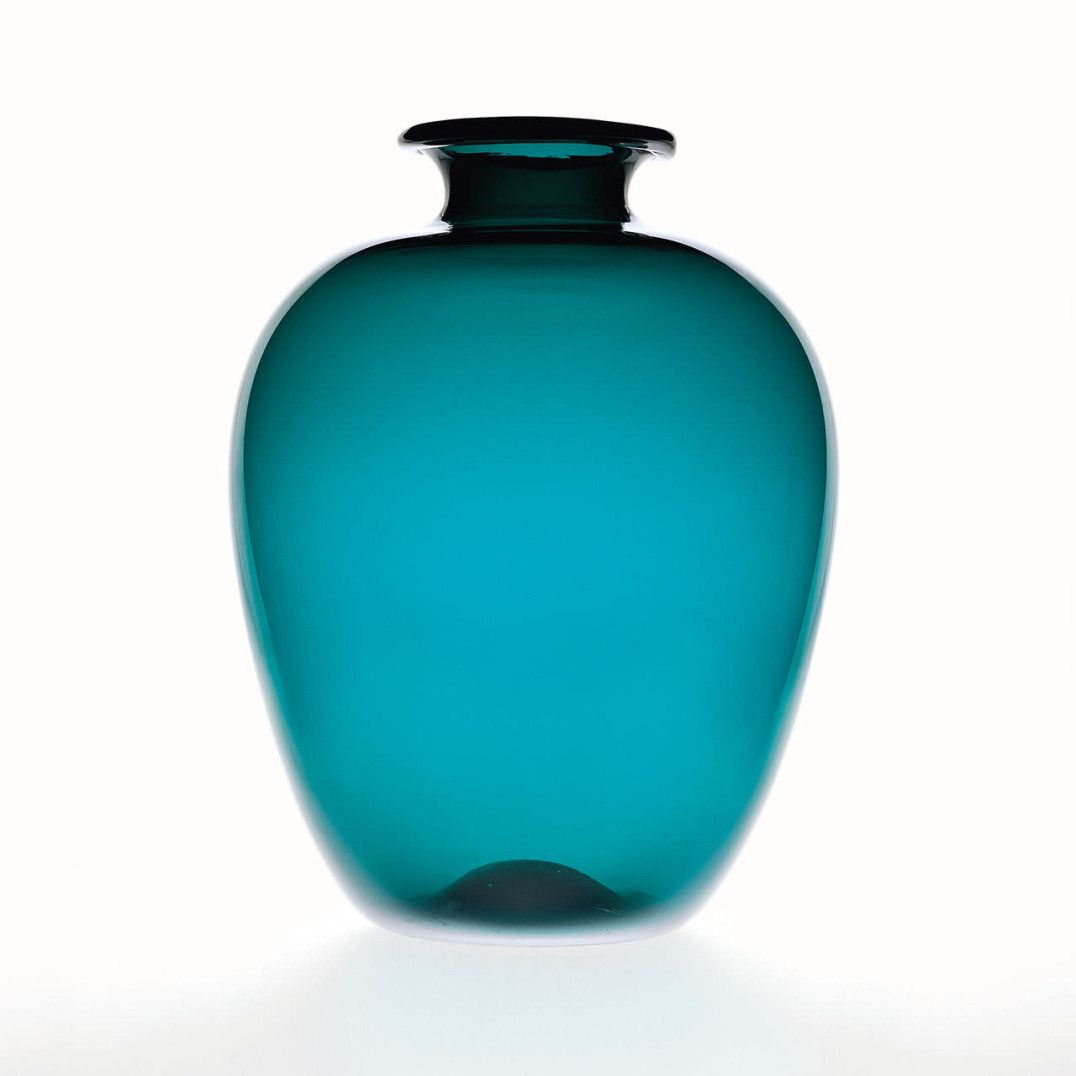
Napoleone MartinuzziTrasparente, ca. 1927
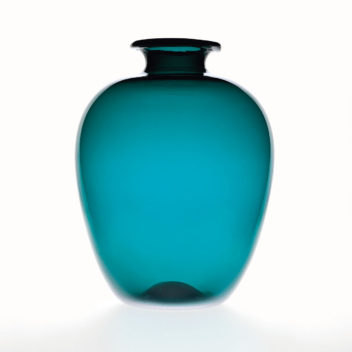
Napoleone MartinuzziTrasparenteV.S.M. Venini & C., ca. 1927
Large vase in transparent green glass.
Acid stamped:
venini murano ITALIA and paper label: n. 137.
17 in. high (43.2 cm)
Exhibitions:
2000, New York, Venetian Glass, Museum of Arts & Design;
2001, Milan, Murano: Vetri dalla Collezione Olnick Spanu,
Spazio Oberdan.
Bibliography and comparative texts:
W. Neuwirth, 1987, n. 6;
Olnick Spanu, 2000, n. 12;
Olnick Spanu, 2001, n. 19.
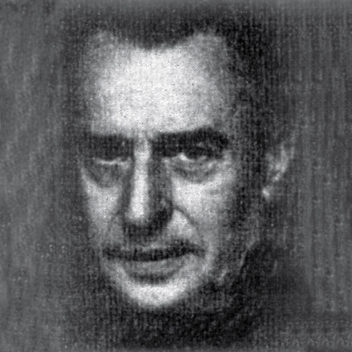
Napoleone Martinuzzi 1892–1977
The son of a glassworker from Murano, Napoleone Martinuzzi was a sculptor, designer, and businessman. He attended the Accademia di Belle Arti di Venezia, and later joined the secessionist group of Cà Pesaro, where he exhibited his sculptures in 1908. From 1917 on, he was Gabriele D'Annunzio's favorite artist and he designed a funeral monument for him, as well as sculpture and many works in glass, which may still be seen today at the Vittoriale. Between 1921 and 1931, he directed the Museo Vetrario di Murano, and in 1925 he became a partner and artistic director at the Vetri Soffiati Muranesi Venini & C. After carrying on the concepts defined by his predecessor, Vittorio Zecchin, and creating beautifully transparent blown glass pieces, he elaborated on his own distinct style, directly derived from his experience as a Novecento sculptor. In 1928, he made his first pieces in pulegoso glass, giving life to a sculptural series of vessels with impressive shapes and vivid colors, as well as an unusual collection of cacti, fruits, and animals. After leaving Venini, in 1932 he founded Zecchin-Martinuzzi Vetri Artistici e Mosaici with Francesco Zecchin, for which he designed figures of animals and cacti, opaque vessels with classical shapes, and female nudes in solid massiccio glass. He became artistic director of Alberto Seguso's Arte Vetro, where he made glass sculptures shaped while hot. Between 1953 and 1958, he designed chandeliers and glass tiles for the Vetreria Cenedese. In the '60s and '70s, he designed works produced by Alfredo Barbini for Pauly & C.
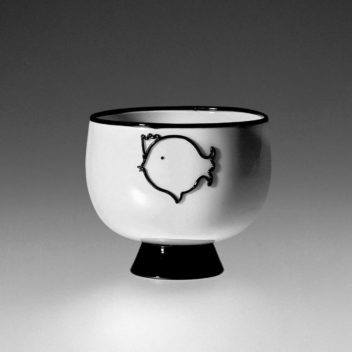
V.S.M. Venini & C. 1925–1932
In 1925, following the closing of Cappellin Venini & C., Paolo Venini founded his own glass company, which he called Vetri Soffiati Muranesi Venini & C. (V.S.M. Venini & C.). While the company, under the artistic direction of sculptor Napoleone Martinuzzi, produced collections designed by Vittorio Zecchin, it soon became known for the pulegosi, an original style created by Venini and Martinuzzi. In 1932, both Martinuzzi and Zecchin left the company. Paolo Venini changed the name of the company to Venini & C. and Milanese architect Tommaso Buzzi became the new artistic director.
Napoleone MartinuzziTrasparente, ca. 1927
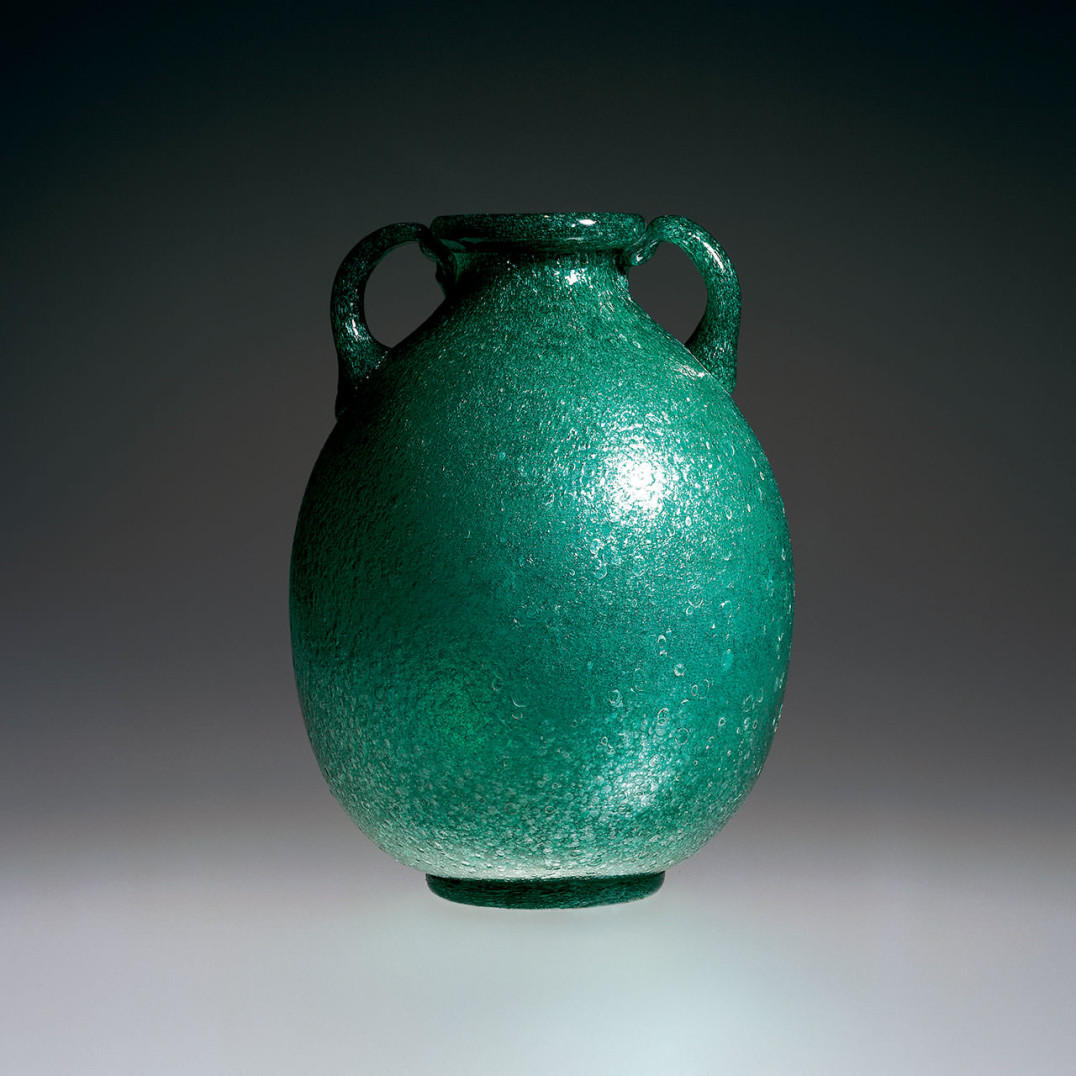
Napoleone MartinuzziPulegoso, 1928-1930
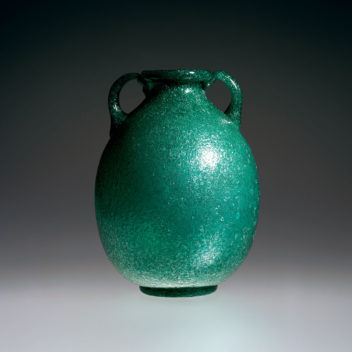
Napoleone MartinuzziPulegosoV.S.M. Venini & C., 1928-1930
Amphora-shaped vessel in green pulegoso glass with two small, applied handles.
12 1/4 in. high (31.1 cm)
Exhibitions:
2001, Milan, Murano: Vetri dalla Collezione Olnick Spanu,
Spazio Oberdan.
Bibliography and comparative texts:
Venini, blue catalogue, n. 3255;
F. Deboni, 1989, n. 8;
M. Barovier, 1992, n. 16;
Olnick Spanu, 2001, n. 20.

Napoleone Martinuzzi 1892–1977
The son of a glassworker from Murano, Napoleone Martinuzzi was a sculptor, designer, and businessman. He attended the Accademia di Belle Arti di Venezia, and later joined the secessionist group of Cà Pesaro, where he exhibited his sculptures in 1908. From 1917 on, he was Gabriele D'Annunzio's favorite artist and he designed a funeral monument for him, as well as sculpture and many works in glass, which may still be seen today at the Vittoriale. Between 1921 and 1931, he directed the Museo Vetrario di Murano, and in 1925 he became a partner and artistic director at the Vetri Soffiati Muranesi Venini & C. After carrying on the concepts defined by his predecessor, Vittorio Zecchin, and creating beautifully transparent blown glass pieces, he elaborated on his own distinct style, directly derived from his experience as a Novecento sculptor. In 1928, he made his first pieces in pulegoso glass, giving life to a sculptural series of vessels with impressive shapes and vivid colors, as well as an unusual collection of cacti, fruits, and animals. After leaving Venini, in 1932 he founded Zecchin-Martinuzzi Vetri Artistici e Mosaici with Francesco Zecchin, for which he designed figures of animals and cacti, opaque vessels with classical shapes, and female nudes in solid massiccio glass. He became artistic director of Alberto Seguso's Arte Vetro, where he made glass sculptures shaped while hot. Between 1953 and 1958, he designed chandeliers and glass tiles for the Vetreria Cenedese. In the '60s and '70s, he designed works produced by Alfredo Barbini for Pauly & C.

V.S.M. Venini & C. 1925–1932
In 1925, following the closing of Cappellin Venini & C., Paolo Venini founded his own glass company, which he called Vetri Soffiati Muranesi Venini & C. (V.S.M. Venini & C.). While the company, under the artistic direction of sculptor Napoleone Martinuzzi, produced collections designed by Vittorio Zecchin, it soon became known for the pulegosi, an original style created by Venini and Martinuzzi. In 1932, both Martinuzzi and Zecchin left the company. Paolo Venini changed the name of the company to Venini & C. and Milanese architect Tommaso Buzzi became the new artistic director.
Napoleone MartinuzziPulegoso, 1928-1930
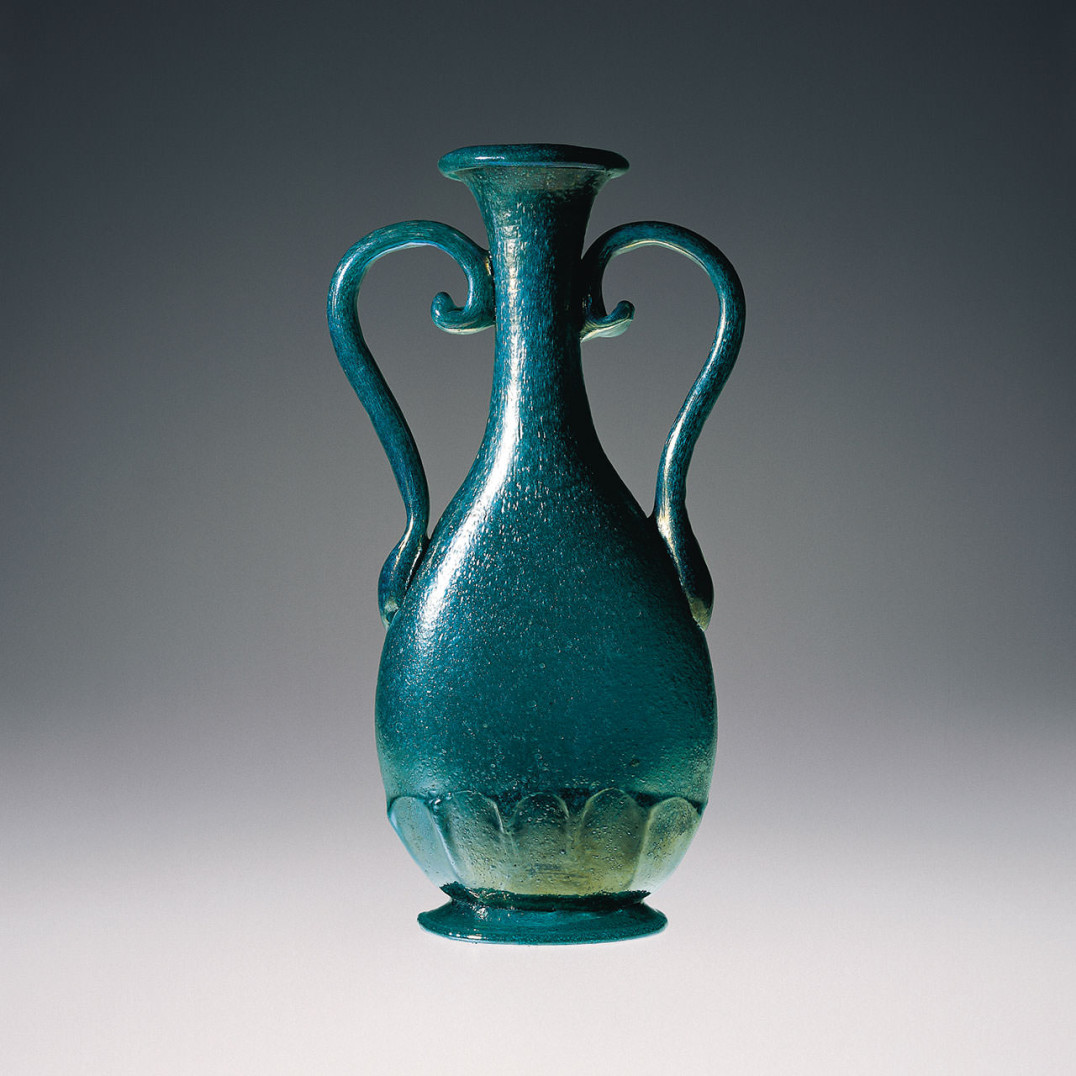
Napoleone MartinuzziPulegoso, 1928-1930
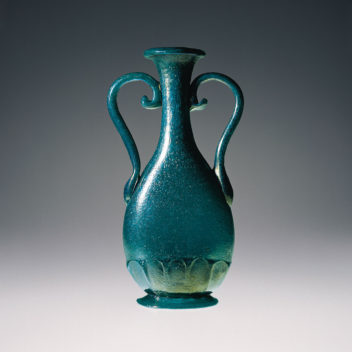
Napoleone MartinuzziPulegosoV.S.M. Venini & C., 1928-1930
Amphora-shaped vessel in green pulegoso glass with two large handles and ribbed base.
17 3/4 in. high (45.1 cm)
Exhibitions:
1930, Venice, 17th Biennale Internazionale d’Arte;
1930, Monza, 4th Esposizione Internazionale delle Arti Decorative
e Industriali Moderne;
2000, New York, Venetian Glass, Museum of Arts & Design;
2001, Milan, Murano: Vetri dalla Collezione Olnick Spanu, Spazio Oberdan.
Bibliography and comparative texts:
M. Karasik, 1989, n. 2;
A. Venini Diaz de Santillana, 1996, n. 25;
Olnick Spanu, 2000, n. 14;
Olnick Spanu, 2001, n. 21.

Napoleone Martinuzzi 1892–1977
The son of a glassworker from Murano, Napoleone Martinuzzi was a sculptor, designer, and businessman. He attended the Accademia di Belle Arti di Venezia, and later joined the secessionist group of Cà Pesaro, where he exhibited his sculptures in 1908. From 1917 on, he was Gabriele D'Annunzio's favorite artist and he designed a funeral monument for him, as well as sculpture and many works in glass, which may still be seen today at the Vittoriale. Between 1921 and 1931, he directed the Museo Vetrario di Murano, and in 1925 he became a partner and artistic director at the Vetri Soffiati Muranesi Venini & C. After carrying on the concepts defined by his predecessor, Vittorio Zecchin, and creating beautifully transparent blown glass pieces, he elaborated on his own distinct style, directly derived from his experience as a Novecento sculptor. In 1928, he made his first pieces in pulegoso glass, giving life to a sculptural series of vessels with impressive shapes and vivid colors, as well as an unusual collection of cacti, fruits, and animals. After leaving Venini, in 1932 he founded Zecchin-Martinuzzi Vetri Artistici e Mosaici with Francesco Zecchin, for which he designed figures of animals and cacti, opaque vessels with classical shapes, and female nudes in solid massiccio glass. He became artistic director of Alberto Seguso's Arte Vetro, where he made glass sculptures shaped while hot. Between 1953 and 1958, he designed chandeliers and glass tiles for the Vetreria Cenedese. In the '60s and '70s, he designed works produced by Alfredo Barbini for Pauly & C.

V.S.M. Venini & C. 1925–1932
In 1925, following the closing of Cappellin Venini & C., Paolo Venini founded his own glass company, which he called Vetri Soffiati Muranesi Venini & C. (V.S.M. Venini & C.). While the company, under the artistic direction of sculptor Napoleone Martinuzzi, produced collections designed by Vittorio Zecchin, it soon became known for the pulegosi, an original style created by Venini and Martinuzzi. In 1932, both Martinuzzi and Zecchin left the company. Paolo Venini changed the name of the company to Venini & C. and Milanese architect Tommaso Buzzi became the new artistic director.
Napoleone MartinuzziPulegoso, 1928-1930
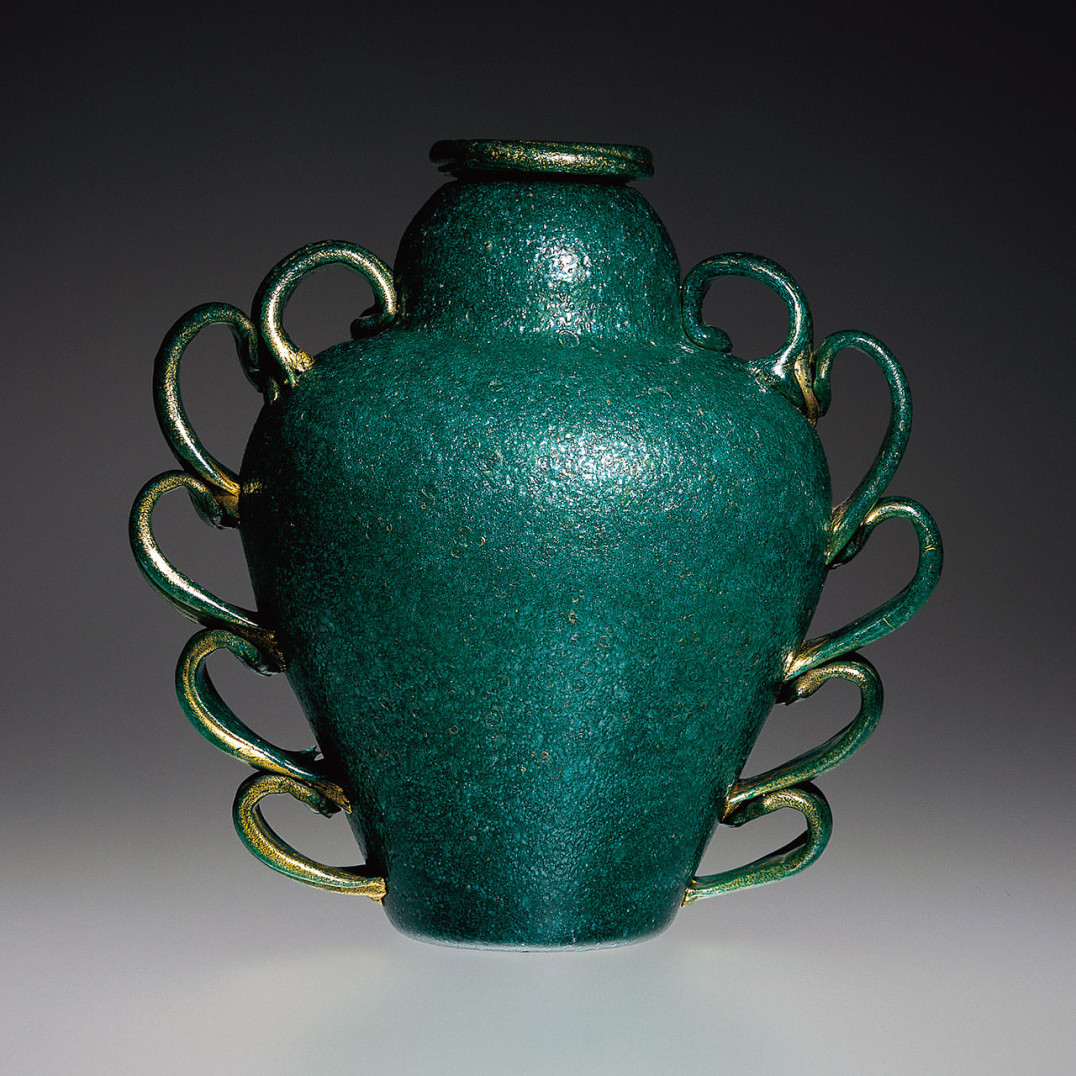
Napoleone MartinuzziPulegoso, 1930
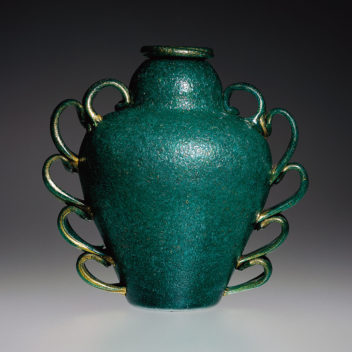
Napoleone MartinuzziPulegosoV.S.M. Venini & C., 1930
Amphora-shaped vase in green pulegoso glass. Ten applied handles and mouth are decorated with gold leaf applications. A similar model was part of the collection of the poet Gabriele d’Annunzio, now on exhibition in the Stanza della Zambracca at the Il Vittoriale degli Italiani museum on Lake Garda.
13 1/2 in. high (34.3 cm)
Exhibitions:
1930, Venice, 17th Biennale Internazionale d’Arte; 1930, Monza, 4th Esposizione Internazionale delle Arti Decorative e Industriali Moderne;
2000, New York, Venetian Glass, Museum of Arts & Design; 2001, Milan, Murano: Vetri dalla Collezione Olnick Spanu, Spazio Oberdan.
Bibliography and comparative texts:
Venini blue catalogue, n. 3273:
photo n. 431, Triennale archives;
C.A. Felice, 1931, p. 64; G. Lorenzetti, 1931;Vetri Murano…, 1981, p. 30;
Mille anni…, 1982, n. 525; R. Bossaglia, M. Quesada, 1988, n. 338 a;
F. Deboni, 1989, n. 14; G. Duplani Tucci, 1989, n. 11; M. Barovier, 1992, n. 80; L’arte del vetro, 1992, n. 327;
F. Deboni, 1996, n. 180; A. Venini Diaz de Santillana, 1996, n. 20;
R. Barovier Mentasti, 1998, n. 38;
M. Barovier, 1999, p. 159; A. Venini Diaz de Santillana, 2000, n. 44;
Olnick Spanu, 2000, n. 13;
Olnick Spanu, 2001, n. 22.

Napoleone Martinuzzi 1892–1977
The son of a glassworker from Murano, Napoleone Martinuzzi was a sculptor, designer, and businessman. He attended the Accademia di Belle Arti di Venezia, and later joined the secessionist group of Cà Pesaro, where he exhibited his sculptures in 1908. From 1917 on, he was Gabriele D'Annunzio's favorite artist and he designed a funeral monument for him, as well as sculpture and many works in glass, which may still be seen today at the Vittoriale. Between 1921 and 1931, he directed the Museo Vetrario di Murano, and in 1925 he became a partner and artistic director at the Vetri Soffiati Muranesi Venini & C. After carrying on the concepts defined by his predecessor, Vittorio Zecchin, and creating beautifully transparent blown glass pieces, he elaborated on his own distinct style, directly derived from his experience as a Novecento sculptor. In 1928, he made his first pieces in pulegoso glass, giving life to a sculptural series of vessels with impressive shapes and vivid colors, as well as an unusual collection of cacti, fruits, and animals. After leaving Venini, in 1932 he founded Zecchin-Martinuzzi Vetri Artistici e Mosaici with Francesco Zecchin, for which he designed figures of animals and cacti, opaque vessels with classical shapes, and female nudes in solid massiccio glass. He became artistic director of Alberto Seguso's Arte Vetro, where he made glass sculptures shaped while hot. Between 1953 and 1958, he designed chandeliers and glass tiles for the Vetreria Cenedese. In the '60s and '70s, he designed works produced by Alfredo Barbini for Pauly & C.

V.S.M. Venini & C. 1925–1932
In 1925, following the closing of Cappellin Venini & C., Paolo Venini founded his own glass company, which he called Vetri Soffiati Muranesi Venini & C. (V.S.M. Venini & C.). While the company, under the artistic direction of sculptor Napoleone Martinuzzi, produced collections designed by Vittorio Zecchin, it soon became known for the pulegosi, an original style created by Venini and Martinuzzi. In 1932, both Martinuzzi and Zecchin left the company. Paolo Venini changed the name of the company to Venini & C. and Milanese architect Tommaso Buzzi became the new artistic director.